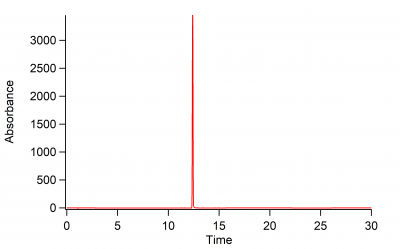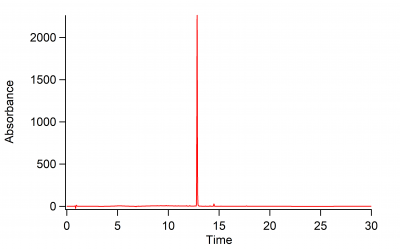Difference between revisions of "Oxybenzone Oxidation"
| Line 5: | Line 5: | ||
Our actual samples to be tested required the making of a 2 mM oxybenzone pH 5 buffer stock solution, a hydrogen peroxide stock solution, and a horseradish peroxidase solution. | Our actual samples to be tested required the making of a 2 mM oxybenzone pH 5 buffer stock solution, a hydrogen peroxide stock solution, and a horseradish peroxidase solution. | ||
| − | 2 mM Oxybenzone Buffer Stock Solution | + | ''2 mM Oxybenzone Buffer Stock Solution'' |
Combined 50 mL of dioxane, 50 mL of pH 5 buffer solution, and 45.7 mg of oxybenzone in a bottle. Added the oxybenzone to the dioxane, and then added the buffer solution. | Combined 50 mL of dioxane, 50 mL of pH 5 buffer solution, and 45.7 mg of oxybenzone in a bottle. Added the oxybenzone to the dioxane, and then added the buffer solution. | ||
| − | Hydrogen Peroxide Stock Solution | + | ''Hydrogen Peroxide Stock Solution'' |
Measured 5 mL of water into a scintillation vial. Added 283 microliters of 30% hydrogen peroxide to the water. This provided a hydrogen peroxide solution of about 0.413 M. | Measured 5 mL of water into a scintillation vial. Added 283 microliters of 30% hydrogen peroxide to the water. This provided a hydrogen peroxide solution of about 0.413 M. | ||
| − | Horseradish Peroxidase Stock Solution | + | ''Horseradish Peroxidase Stock Solution'' |
| − | Preparing the Final Samples | + | ''Preparing the Final Samples'' |
Measured out 5 mL of the 2 mM oxybenzone buffer stock solution into 4 different scintillation vials. Added hydrogen peroxide solution in different amounts to each vial (6 microliters, 12 microliters, 18 microliters, and 24 microliters). Add 10 microliters of horseradish peroxidase solution to each vial. | Measured out 5 mL of the 2 mM oxybenzone buffer stock solution into 4 different scintillation vials. Added hydrogen peroxide solution in different amounts to each vial (6 microliters, 12 microliters, 18 microliters, and 24 microliters). Add 10 microliters of horseradish peroxidase solution to each vial. | ||
Revision as of 02:50, 20 November 2019
The oxidation of oxybenzone was attempted with a reaction of oxybenzone, hydrogen peroxide, and horseradish peroxidase.
Making the Samples For Enzymatic Oxidation
Our actual samples to be tested required the making of a 2 mM oxybenzone pH 5 buffer stock solution, a hydrogen peroxide stock solution, and a horseradish peroxidase solution.
2 mM Oxybenzone Buffer Stock Solution
Combined 50 mL of dioxane, 50 mL of pH 5 buffer solution, and 45.7 mg of oxybenzone in a bottle. Added the oxybenzone to the dioxane, and then added the buffer solution.
Hydrogen Peroxide Stock Solution
Measured 5 mL of water into a scintillation vial. Added 283 microliters of 30% hydrogen peroxide to the water. This provided a hydrogen peroxide solution of about 0.413 M.
Horseradish Peroxidase Stock Solution
Preparing the Final Samples
Measured out 5 mL of the 2 mM oxybenzone buffer stock solution into 4 different scintillation vials. Added hydrogen peroxide solution in different amounts to each vial (6 microliters, 12 microliters, 18 microliters, and 24 microliters). Add 10 microliters of horseradish peroxidase solution to each vial.
Unfortunately, our enzymatic oxidation was unsuccessful, so our focus turned to chemical oxidation.
Making the Samples For Chemical Oxidation
2 mM Oxybenzone Buffer Stock Solution
Combined 50 mL of dioxane, 50 mL of pH 5 buffer solution, and 45.7 mg of oxybenzone in a bottle. Added the oxybenzone to the dioxane, and then added the buffer solution.
Potassium Permanganate Stock Solution
Preparing the final samples
Measured out 5 mL of the 2 mM oxybenzone buffer stock solution into 4 different scintillation vials. Added potassium permanganate solution in increasing concentrations to each vial (6 microliters, 12 microliters, 18 microliters, and 24 microliters).
Data

